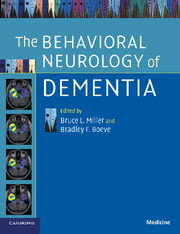Book contents
- Frontmatter
- Contents
- List of contributors
- Section 1 Introduction
- Section 2 Cognitive impairment, not demented
- 12 Cerebrovascular contributions to amnestic mild cognitive impairment
- 13 Mild cognitive impairment
- 14 Mild cognitive impairment subgroups
- 15 Early clinical features of the parkinsonian-related dementias
- 16 Dementia treatment
- 17 Dementia and cognition in the oldest-old
- Section 3 Slowly progressive dementias
- Section 4 Rapidly progressive dementias
- Index
- References
17 - Dementia and cognition in the oldest-old
Published online by Cambridge University Press: 31 July 2009
- Frontmatter
- Contents
- List of contributors
- Section 1 Introduction
- Section 2 Cognitive impairment, not demented
- 12 Cerebrovascular contributions to amnestic mild cognitive impairment
- 13 Mild cognitive impairment
- 14 Mild cognitive impairment subgroups
- 15 Early clinical features of the parkinsonian-related dementias
- 16 Dementia treatment
- 17 Dementia and cognition in the oldest-old
- Section 3 Slowly progressive dementias
- Section 4 Rapidly progressive dementias
- Index
- References
Summary
Introduction
Fueled by medical and technological advances, average life expectancy in the USA has increased by more than 25 years over the past century. A consequence of increased longevity and the aging of the “baby boomers” is that the oldest-old (age 90 or older) have become the fastest growing segment of the US population. Currently, there are fewer than 2 million Americans aged 90 and older, but this number will increase to approximately 10 million by 2050. In terms of percentage of the population, those aged 90 and older presently represent 0.5% of the population in the USA, while by the middle of the twenty-first century, they will form about 2.5% of the population as depicted in Fig. 17.1. Moreover, the increases in the oldest-old population are occurring worldwide. Countries including Japan, France, Italy and Germany are expected to have between 3 and 5% of their population aged 90 and over by 2050.
Cognition in the oldest-old: key questions
What is the prevalence of dementia in the oldest-old?
What are the causes of dementia in the oldest-old?
How can we screen for dementia in this population and what challenges must we overcome in the cognitive assessment of this age group?
What are the clinical–pathological correlates of dementia in the oldest-old?
The rapidly growing population over the age of 90 signals a need to understand aging and age-related conditions in the oldest-old. Many issues require investigation in these pioneers of aging. Estimates of dementia prevalence vary as described in more detail below.
- Type
- Chapter
- Information
- The Behavioral Neurology of Dementia , pp. 254 - 263Publisher: Cambridge University PressPrint publication year: 2009
References
- 2
- Cited by



